War History online proudly presents this Guest Piece from Chris Knupp
This class of cruiser is perhaps one of the more confusing ships ever put to sea by the United States. Designed to prowl the oceans and hunt down enemy commerce raiders, they possessed high speed and considerable firepower. Vastly more powerfully than typical cruisers and at a disadvantage against battleships, the classification of these ships has divided historians. Today, we look at the unique features and challenging design history of these warships and try to find where they fit.
The Idea behind the Alaska Class
The forerunner to the Alaska class design got its start as a result of the introduction of the German “pocket battleships.” Well armed and with a respectable speed, they posed a threat to merchant vessels. Britain, France, and the United States all worked on new designs intended to counter this threat. However, for the US, the designs remained on the drawing board. They would be resurrected years later following rumors of supposed “super cruisers” Japan was thought to be building.
While some in the Navy felt that designing ships solely to hunt down commerce raiders was a waste of resources, others thought the threat was grave enough to warrant these new vessels. President Franklin D. Roosevelt was one such proponent of these new cruisers and strongly pushed for their construction. It is possible that the Alaska class was created as a result of politics rather than wartime thinking.
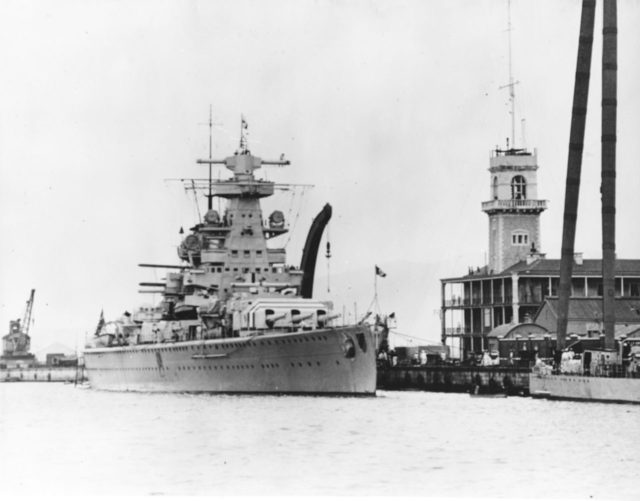
A ship born from politics would certainly explain the confusing design process. The designers initially had no clear idea on what role the ship was to perform and produced a wide variety of designs. At one point there were no less than nine separate designs. Designs ranged from 6,000 ton fast cruisers to enlarged heavy cruisers and even a 38,000 ton “light” battleship. However, General Board finally settled on a design that was essentially an enlarged Baltimore class heavy cruiser. The reuse of a hull design coupled with the adoption of the machinery from the Essex class carriers suggests that designs attempted to save money. They were also ordered at a time when Japan was known to possess a very powerful fleet of cruisers. It is possible that utilizing existing components might have accelerated development of these ships to counter the threat of Japan’s cruisers. Perhaps aware of the increasing power of aircraft carriers, designers were also quick to ensure the ships would be well suited to screening the carriers as well.
The Design Features of the Alaska Class
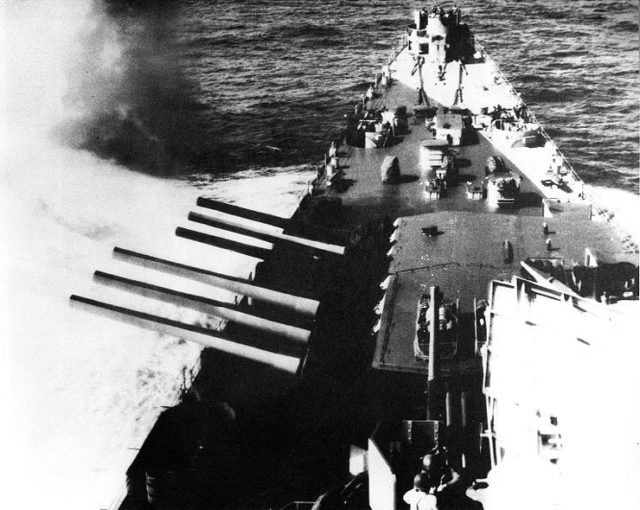
Firepower
Being the middle ground between battleship and cruiser, it was only natural that the Alaska class carry an intermediate weapon. The 12″/50 Mark 8 Naval gun was a return to a barrel size not used by the US in over three decades. However, the Mark 8 represented an entirely different breed of naval cannon. Like the larger 16″ weapons of the US battleships, the Alaska class received their own “super heavy” shells. When firing these shells, the Mark 8 offered performance slightly superior to that of US battleships mounting 14″ naval guns. In this regard, the Mark 8 could be considered the most powerful naval gun of World War 2 in terms of size. Had the Alaska class ever had the opportunity to fight the German raiders or Japanese super cruisers, they would have had an impressive advantage in firepower.
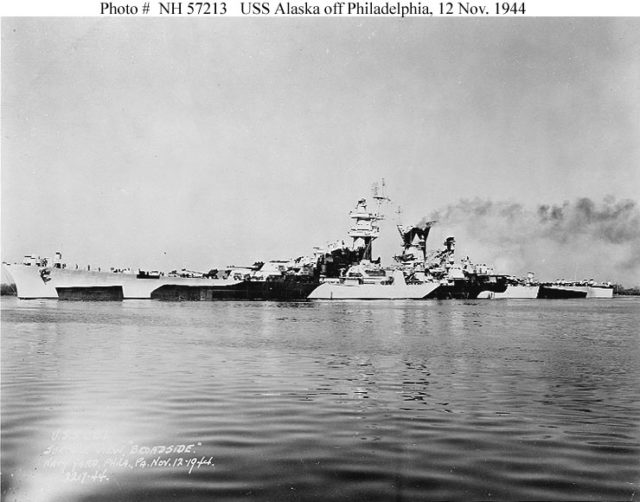
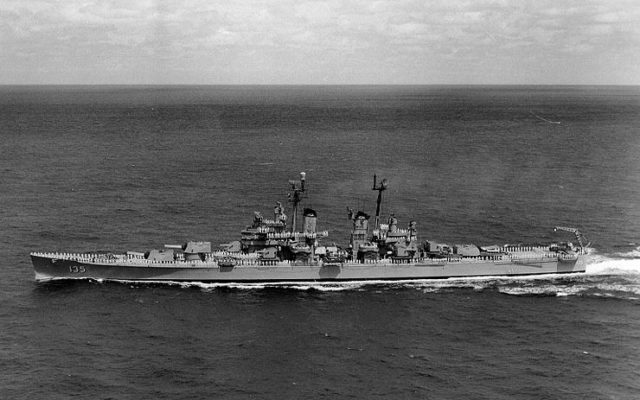
When compared to the Baltimore class cruiser, one can immediately spot the similarities in the arrangement of the secondary weapons. The arrangement of the 5″ secondary guns is immediately clear with the dual port and starboard mounts. Two additional mounts are superfiring over the main cannons. Even the 40mm and 20mm Anti-air weapons are arranged in a similar manner.
Of particular note in the photos is the location of the aircraft catapults. Despite being based on the Baltimore class, the Alaska class opted for the amidships aircraft catapults like older US cruisers. Some felt this was detrimental as the location could have housed additional 5″ gun mounts and increased anti-aircraft weaponry.
Armor
Armor would prove to be the greatest weakness of the Alaska class. Being designed as “cruiser killers” they were essentially designed to resist cruiser guns and not much else.In an effort to reduce weight, the Alaska class cruisers were designed without a torpedo defense system. What little protection they had was against a 700lb warhead at a time when Japan was fielding torpedoes with 1100lbs of explosives.
What the Alaska class lacked in underwater protection, they made up for it in gunfire protection. Against 8″ cruiser gunfire, they were protected at 10k to 30k yards. Even the larger German 11″ shell would have difficulty penetrating the belt at typical combat ranges. Had the Alaska class gotten the chance to actually hunt down Axis cruisers, they would have been formidable opponents.
On the subject of protection, it should be noted that the Alaska class devoted only 28.4% of their tonnage to armor compared to the 32% or more that battleships typically did. Battlecruisers traditionally devoted anywhere from 19.5% (HMS Invincible),29% (Lexington class Battlecruiser), and even up to 32% (HMS Hood) of their tonnage to armor, a category the Alaska class squarely falls into.
Power Plant
The Alaska class utilized the same machinery as the larger Essex class carriers. Eight boilers drove four turbines producing a total of 150,000shp. At standard output, the Alaska class cruisers were able to achieve up to 33 knots. Their high speed enabled them to easily keep pace with carriers and during World War 2, they were known to be exceptional escort vessels.
While fast in a straight line, they were not particularly agile. With their long length and single rudder, they had a large turning radius of 800 yards. Most US ships, even some of the larger battleships and carriers, could turn inside of the Alaska class.
Cruiser or Battlecruiser?
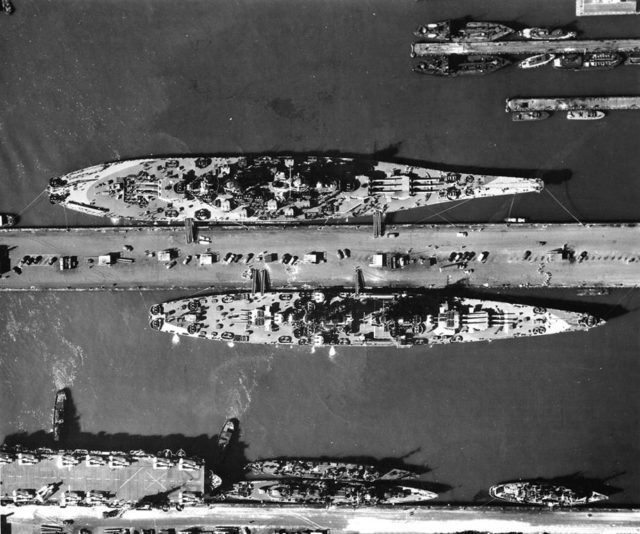
USS Alaska alongside the Battleship USS Missouri. The large size of the Alaska class is evident.
The designation of the Alaska class has always been a source of argument among historians. Even the US Navy themselves appears confused by the ships. Initially labeled with the battlecruiser designation of CC early in development, they were later relabeled with the CB designation of large cruiser. Afterward, the Navy made it a habit to discourage the labeling of these ships as battlecruisers.
Despite Naval policy, modern historians commonly designate them battlecruisers and for good reason.
- Like traditional battlecruisers, the Alaska class were lightly armored, but fast and powerfully armed.
- They were designed to hunt down commerce raiders as well as sweep the oceans of enemy cruisers, both roles that battlecruisers were originally intended to perform.
- They were expected to use their speed to hunt down anything slower while evading anything more powerful.
- They were also expected to operate outside of the main battle line and support the fleet through interception of support vessels.
With this in mind, why would a ship designed to perform the battlecruiser role be labeled anything else? Surely if it looks like a battlecruiser and performs like a battlecruiser, it must be a battlecruiser.
The likely explanation for the large cruiser designation is due to the construction and design of the Alaska class rather than role.
Traditionally, battlecruisers were of the same size and possessed the same armament that battleships did. The Alaska class did not meet either of these criteria. As torpedoes became more prevalent, all capital ships (including surviving battlecruisers) were intended to have torpedo defense systems installed. In the Alaska class, torpedo protection was sacrificed and anti-torpedo bulges were omitted entirely.
With the exception of armor, battlecruisers shared many similarities with battleships. However, the Alaska class would be an exception. They used the same armor scheme, weapons arrangement, and general design characteristics of heavy cruisers but on a much larger scale. In this regard, the term “large cruiser” is accurate.
Final Opinion
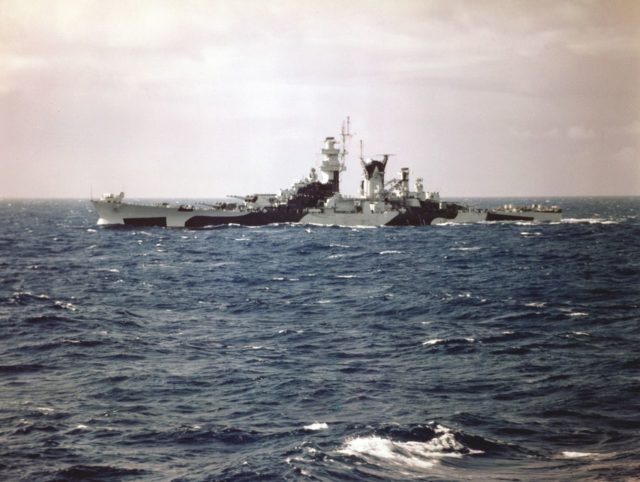
The best way to look at the Alaska class might be to ignore the older ideas of a battlecruiser and look at them as their own design.
Other nations fulfilled the battlecruiser role by designing vessels like battleships, but stripped of armor and other features to gain speed. The US however, went with a different approach. They fulfilled the battlecruiser role by creating a larger, more powerful heavy cruiser. A cruiser design already offered less armor and higher speed, but by enlarging the ship they gaining the heavier firepower.
They were a unique design, much like the other hybrid types the US was fond of during World War 2. For instance, the Iowa class could be seen as a fusion of Battleship and Battlecruiser. A battleship that could fulfill the battlecruiser role with its high speed. Likewise, the Alaska class could be described as a fusion of heavy cruiser and battlecruiser, a large cruiser that could act as a battlecruiser due to its larger size and heavier firepower.
There were many battlecruisers, there were many heavy cruisers, but the Alaska design was its own unique design between them.
Thank you for reading my latest article. If you want to check out more of my work, you can access my collection here at navalgeneralboard.com
Author: Chris Knupp
All photos provided by the author.
